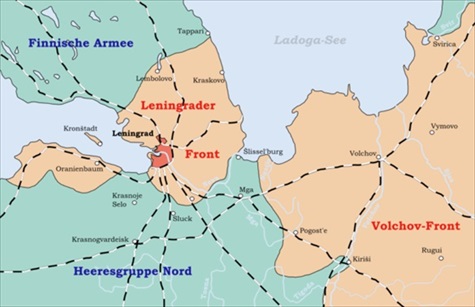LENINGRAD, SIEGE OF (1941–1944)
| When | September 8, 1941 to January 27, 1944 (872 days) |
| Where | Leningrad (today’s St. Petersburg), Russia
|
| Who | German Army Group North (on map, Herresgruppe Nord) initially under Field Marshal Wilhelm Ritter von Leeb (1876–1956) with token support to the north and east of Leningrad from German-allied Finnish units under Marshal Carl Gustaf Mannerheim (1867–1951). In January 1942 von Leeb was relieved of his command and replaced by Col-Gen. Georg von Kuechler (1881–1968), who that August was replaced by Field Marshal Erich von Manstein (1887–1973). Arrayed against Army Group North were the Soviet Leningrad Front under various commanders, among them Gen. Georgy Zhukov (1896–1974) and from June 1942 Marshal Leonid Govorov (1897–1955), and the Volkhov Front under Gen. Kirill Meretskov (1897–1968). The Volkhov Front was disbanded and incorporated into the Leningrad Front in April 1942. Total military strength with reserves and volunteers reached two million men on all sides when the siege began. |
| Why | Leningrad was an early target of Hitler’s Operation Barbarossa, lying across the path of the German advance into the north of Russia and around to the east of Moscow, the capital of the Soviet Union. If German forces could unite with the small, but tough, motivated, and skilled Finnish forces, their combined armies could quite possibly drive through Northern Russia, capture Moscow, and win the war for Germany. |
| What | At the outbreak of World War II, Leningrad was a city of three million people lying in the far north of Russia. (Leningrad is roughly at the same latitude as Anchorage, Alaska.) It was the second largest city in Soviet Russia and represented 11 percent of the national economy. Situated on the Gulf of Finland, Leningrad was a nexus of road, rail, and shipping links between the Baltic Sea and the Soviet interior. On June 22, 1941, Army Group North surged across the Soviet border, ripped through the Baltic States (Lithuania, Latvia, and Estonia) and by September 1 was lobbing artillery rounds into the city. |
| Outcome | When Hitler switched Operation Barbarossa’s priorities to targets in the Ukraine and the Caucasus oilfields on September 6, 1941, drawing down von Leeb’s panzer strength, the assault on Leningrad was converted into a siege (the Soviets called it a “blokada”) with constant long-range artillery and aerial bombardment, which in turn was crippled on the German side by a rotation of increasingly frustrated army commanders. Germans looted artworks and destroyed historic landmarks outside the defensive perimeter (e.g., the summer residence of the Russian tsars at Pushkin and the Gatchina Palace), while inside the Russian lines food depots, apartment blocks, factories, schools, hospitals, transport facilities, and other civil infrastructure were laid to waste. A narrow and dangerous corridor of water or ice on the east side of the city (variously known as the “Road of Life” [Doroga Zhinzni] and the “Road of Death”) struggled to supply a starving population with food and fuel. One million people used the road to escape. On city streets the dead piled up, covered by snow until spring. On one day alone, 13,500 deaths occurred. People close to starvation used canes to walk. One who had survived the blokada recalled: “To take someone who has died to the cemetery is an affair of so much labor that it exhausts the last strength in the survivors. The living, having fulfilled their duty to the dead, are themselves brought to the brink of death.” Still, the city tried to act like a city, not a cemetery. A few dozen schools stayed open as did 20 movie and playhouses, the Grand Philharmonic played for at least a year, and radio broadcasts continued. By the end of 1943 the German operations around the besieged city had little strategic significance apart from maintaining the overall German frontline. The cruel siege remains one of history’s greatest examples of defiance, but at a ghastly cost: One to 1.5 million Leningraders died from malnutrition, exposure, disease, bombing, and shelling and over one million members of the Soviet armed forces were killed, captured, or declared missing. German casualties are unknown. The January 1944 collapse of the German siege of Leningrad was a key ingredient in the Wehrmacht’s defeat on the Eastern Front. |
![]()
Battlefield: The Siege of Leningrad, 1941–1944 (Skip first 40 seconds)
![]()


 History buffs, there is good news! The Daily Chronicles of World War II is now available as an ebook for $4.99 on Amazon.com. Containing a year’s worth of dated entries from this website, the ebook brings the story of this tumultuous era to life in a compelling, authoritative, and succinct manner. Featuring inventive navigation aids, the ebook enables readers to instantly move forward or backward by month and date to different dated entries. Simple and elegant! Click
History buffs, there is good news! The Daily Chronicles of World War II is now available as an ebook for $4.99 on Amazon.com. Containing a year’s worth of dated entries from this website, the ebook brings the story of this tumultuous era to life in a compelling, authoritative, and succinct manner. Featuring inventive navigation aids, the ebook enables readers to instantly move forward or backward by month and date to different dated entries. Simple and elegant! Click 











